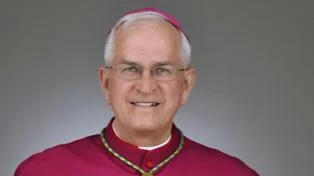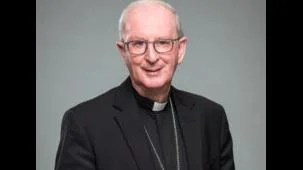
Reverend Joseph E. Kurtz, D.D. Bishop | Archdiocese of Louisville
During his 2016 apostolic visit to Poland for World Youth Day, Pope Francis visited the site of the Auschwitz-Birkenau Nazi death camp in Oswiecim.
Today, the infamous concentration camp area is blanketed by green fields and empty barracks lined by barbed wire fences, a chilling reminder of a horror that remains embedded in history.
The death camp was the Nazis’ largest and consisted of three parts: Auschwitz I, where many were imprisoned and murdered; the Birkenau extermination camp — also known as Auschwitz II — and Auschwitz III (Auschwitz-Monowitz), an area of auxiliary camps that included several factories.
In 1942, Auschwitz became the site of the mass extermination of over 1 million Jews, 23,000 Roma, 15,000 Soviet prisoners of war and thousands of Polish citizens of different nationalities.
Entering through the eerie gates inscribed with the motto “Arbeit macht frei” (“Work sets you free”), the pope quietly sat on a small bench with his head bowed, occasionally glancing somberly around before closing his eyes in silent prayer.
After briefly meeting with about a dozen Holocaust survivors, he passed what was known as the “death wall,” an area where thousands were lined up and shot in the back of the head before their bodies were sent to the camp’s crematoriums.
From there, he made his way toward a darkened cell in the barracks of Block 11, dubbed the “death block” where Nazis mercilessly tortured prisoners. The pope sat quietly with his head bowed in the tiny cell, illuminated by faint candlelight that revealed countless words and even a cross etched on the walls by those who spent their final moments in the starvation cell.
This was no random cell: it was where St. Maximilian Kolbe, a Polish Conventual Franciscan friar, spent his final hours. He was starved and dehydrated before being administered a lethal injection of carbolic acid.
Canonized by St. John Paul II in 1982, the Catholic Church commemorates his martyrdom on Aug. 14. His story serves not only as one among many tales of heroic virtue but also as a cautionary tale for humanity’s future: a story of selflessness amid selfishness and a warning against ideological extremism leading to destruction.
Outside St. Maximilian Kolbe’s cell, Pope Francis wrote a simple message in the visitors’ book: “Lord, have mercy on your people. Lord, forgive so much cruelty.”
In his homily during St. Maximilian Kolbe’s canonization Mass on Oct. 10, 1982, St. John Paul II said Kolbe was granted "the grace of carrying out ‘in an absolutely literal manner’" Christ's words: "Greater love has no man than this, that a man lay down his life for his friends."
When World War II broke out, St. Maximilian Kolbe chose to stay at Niepokalanów monastery where he ran a radio station and temporary hospital. After Poland's invasion, it housed Polish refugees including Jews and published anti-Nazi material.
Arrested in February 1941 and transferred to Auschwitz in May that year, he endured constant beatings but shared food rations with fellow inmates. In July 1941 after one prisoner escaped, Nazis selected ten prisoners to die by starvation including Franciszek Gajowniczek who lamented not seeing his family again. Kolbe offered to take Gajowniczek’s place which was accepted by Nazi commanders.
Taken to Block 11’s starvation bunker with nine others whom he accompanied until their deaths over two weeks without food or water; he died on Aug. 14th while still alive among few remaining prisoners; cremated next day - feast Assumption day.
Father Piotr Bielenin noted that Kolbe’s sacrifice wasn't just for Gajowniczek but also for other nine prisoners accompanying them till end saving faith humanity within them despite illnesses last dying saving dignity showing hope extreme circumstances maintaining freedom choices even smallest flame love surviving darkness evil
Father Bielenin stressed importance today's world valuing human life starting unborn children victims wars injustices ending elderly recalling John Paul II calling him ‘patron difficult century’.
Kolbe’s act gives hope demonstrating dignity preservation under dire conditions reflecting ongoing global conflicts ideologies Christians must avoid adapting Gospel worldly fashions instead shaping lives accordingly while opening church doors preaching lawful ways like Kolbe did primarily through personal testimony living Gospel visibly among non-believers highlighting risk isolation defending positions rather than outreach sharing Christian values exemplified through life actions




 Alerts Sign-up
Alerts Sign-up